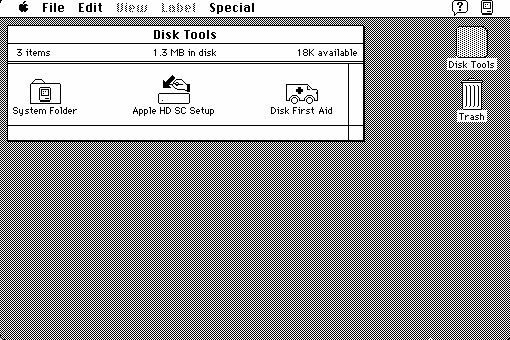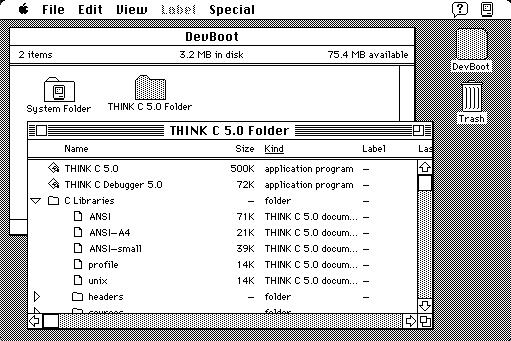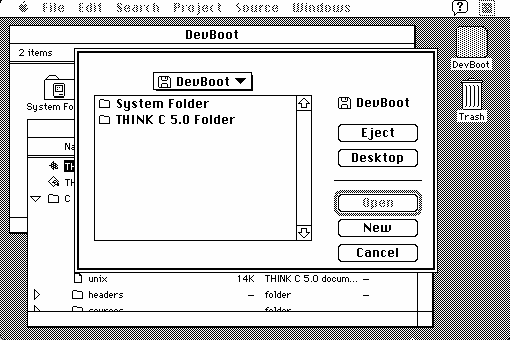
Welcome, child! Come in, come in! I have so few visitors to this little hut. Pull up a chair, and I’ll put on some tea.
I can see from the wedge of machined aluminum you cradle, its outer surface festooned with glyphs and incantations, that you, too, are a programmer. Things have changed so much over the years. What’s that? Oh, you noticed one of my antiques:

An elegant machine from a more enlightened age. A 32-bit processor built by… well, I suppose the details don’t matter. Impossibly slow and cramped compared your starkly modernist folio. Ah, but I see in you a spark of curiosity! Perhaps, perhaps…
I’m afraid my device is too fragile for the roughousing of a novice- it has spent so many years feeling only my touch. Recall, however, the proofs of our saint Turing. We could teach your new machine some old tricks!
Let us begin by weaving a lucid dream; the bones and sinews of my antique. Teach your contraption the language of the Motorola 68000. The timings of raster beams and serial protocols. As is so often the case, another of our order has already made most of the necessary alignments and gestures- we need only tap into that lifestream.
First, a ward of salt, inscribed with the true name of our subject. This name still has power in today’s world, does it not? Take care, child, not to break the perimeter:
$ mkdir Macintosh
$ cd Macintosh
Next, retrieve the means of our communion:
$ wget https://www.gryphel.com/d/minivmac/minivmac-36.04/minivmac-36.04.src.tgz
$ tar -zxvf minivmac-36.04.src.tgz
$ cd minivmac
As suits its manifold nature, this body must be instructed as to the form it should take via a configuration tool which must, itself, be compiled.
$ cc setup/tool.c -o setup_t
$ ./setup_t -t mc64 > setup.sh
$ chmod +x setup.sh
$ ./setup.sh
$ make
$ mv minivmac.app/ ../
$ cd ..
At last, we need an artifact which brings with it the spirit of the machine. The read-only memory of another like mine, deftly flensed from aging silicon and transfigured into pure electrical potential:
$ wget https://web.archive.org/web/20201017004908/https://sites.google.com/site/minivmacapplicationsv6/disk-images-and-roms/vmac.rom -O vMac.ROM
$ open minivmac.app
It lives!

See how the emulated screen scintillates on your modern LCD, the reserved orderliness of 1-bit gray struggling to escape from meddling subpixels and anti-aliasing. Soon, old friend. A plaintive glyph leads us toward our next task. We must assemble a disk image with an operating system. To begin, we require a living specimen from which we may take cuttings.
The seventh system brought with it multitasking, which will make it more familiar to your sensibilities. An older version, stripped of inessential baubles, will maximize the resources available to your personal aspirations.
$ wget https://web.archive.org/web/20201017004910/https://sites.google.com/site/minivmacapplicationsv6/systems-os/System7.zip -O System7.zip
$ unzip System7.zip -d System7
Feed System7.DSK to your homunculus, and see how eagerly it springs into motion:

Next, create an empty vessel. 80 megabytes will prove ample:
$ dd if=/dev/zero of=devboot.dsk bs=83886080 count=1
The Macintosh will shyly accept this offering, and transform its internal structure into something more useful.

Copy the donor System Folder (the one on Disk Tools) into our new boot volume (DevBoot, in our examples), by dragging it from its current location to the destination disk’s icon. From the Special menu, choose Shut Down. There, there, Macintosh. Rest your head. A final command will make the disk we created the default. The time for rest ends. Reawaken!
$ mv devboot.dsk disk1.dsk
$ open ./minivmac.app/
Four megabytes, with cleverness, is sufficient for many tasks…

You have a machine now. But is it truly yours until it has executed a program of your own devising? The native tongue of the Macintosh is Pascal, once a favored tool for instructing the arts of computer science. Alas, as Unix has trampled all opposition, its own systems language has, in nepotistic glee, monopolized the minds of countless students. Ominously taking its name from the speed of light, C has become a mental cage that traps so many…
Oh, I do apologize. These battles were fought long ago. It’s far too late for tears. Sometimes I lose myself.
You know C, of course. Perfectly understandable. It is in the air that surrounds us, now, and you would be innocent to think it has always been so. To begin your exploration of the Macintosh it would be best to start on some familiar ground. Retrieve the installation disks for THINK C 5.0 from the Macintosh Repository- the .zip versions- while I get the kettle.
Of the four disk images, the most important items are the compiler on disk 1 and the self-extracting archive of headers and libraries on disk 2.

THINK C uses project files. Create one.
In the spirit of keeping things familiar- at least at first- we will make use of the ANSI library, which provides a simulated terminal and implementations of the familiar printf(), scanf(), and other friends from stdio. The built-in text editor can also be used to create a source file and add it to the project. Watch the motions of my hand:

Then you need only compose a completely ordinary C89 program, with no strange tricks or idioms whatsoever:

Observe that even from within the warm embrace of ANSI compatibility the signature of main must be void, and there is no argc or argv to be seen. Furthermore, this printf() does not tolerate invocation without at least a single argument beyond its format string. The familiar “down-to” operator --> behaves just as you expect.
From the Project menu, choose Run, or begin spooling command-R into your muscle-memory, and watch as your first program blossoms:

A humble beginning, yes. Perhaps it is too early to see just what makes this little world satisfying, but I must confess, all this talking has left me a bit weary. You have what you need to start, and you can borrow a volume from my bookshelf if you’d like to venture further on your own.
It’s cold outside, but the fire here is warm. You’re welcome to stay as long as you like. So nice to have a visitor.
It isn’t necessary to build Mini vMac from scratch- the maintainers recommend using a prebuilt binary if one is available for your platform. The process described here is shown for completeness and narrative immersion.
If you aren’t using a modern-era Macintosh as your host, some tweaks to the command-line bits above will be necessary.
-t) argument for Mini vMac’s setup_t script should probably be lx64, and the compiled binary will be a single file you can execute with ./ instead of an app bundle launched via open.lx86 for the XO-1 or larm for any subsequent ARM-based models. Additionally, you should set -ci 0 to specify a monochrome framebuffer- the OLPCs use a 16-bit framebuffer, which appears to confuse Mini vMac without this setting. I’ve written a setup script for OLPCs which fixes a few out-of-the-box issues and installs a complete set of development tools and headers. Salt to taste. When downloading files via wget you will probably fail SSL handshakes; use the --no-check-certificate flag to ignore them.